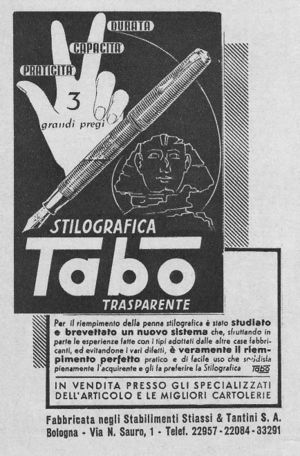Translations:Stiassi e Tantini/7/en
The history of the The Scotland brand is still very uncertain. In 1920 the two Stiassi e Tantini members founded also A.S.C.A., acronym of Azienda Specializzata in Cancelleria ed Affini (meaning Company Specialized in Stationery and Related), and registered the company name The Scotland Pen Italiana with the Chamber of Commerce of Bologna, presumably by virtue of the strong anglophiles trends in the Italian market, which at the time saw many brands using english names. There are no know information about when production was effectively started, but it's generally assumed to be in the '20s.
The trademark registration was done in 1931 (Reg. Gen. N. 44193), and later there was a change in Scotland Italiana, registered in 1936/1937 (Reg. Gen. N. 54732), probably as the result of market trends changes due to the fight against anglophile trends and the exaltation of the Italian naming made by the fascist regime propaganda. The link with Tabo is anyway confirmed by the presence of a oversize model marked Scotland Italiana - Tabo Mod 1926.
The only other known document about the brand is a February 4, 1930 bill on behalf of the "Fabbrica Penne Stilografiche Armando Merighi" company which depicts a fountain pen called "The Scotland Self Filling Pen", for which this company is claiming to be the dealer for the Italian distribution, and Merighi himself registered in the '40s the brand name Mercurio, often found on economic nibs.
The earlier fountain pen production by The Scotland was composed by safety models made both in simple black chased hard rubber or with metal overlays, these ones using laminated gold metal decorated with geometric engravings. There are no known specific names of these models than those previously cited in the bill that reports the following names: special, junior, 9I safetj, zigrinato tipo Waterman 40.
The first celluloid models are, as for many other Italian pens produced in the same period, Duofold imitations. To demonstrate the influence of anglophile names, these models were containing the inscriptions like The Scotland Pen and Self filling in two rows on the body, and gold nib was marked The Scotland Pen and Made in England, these were replaced in the '30s models by nibs marked Scotland Italiana and Made in Italy.
After these models followed, still from the '30s, new streamlined models fitted with the same type of clip and finishes of the previous Duofold imitations, but with tapered ends for cap and barrel. It seems, however, that there was an Omas role in the production of some later models, known as The Scotland Prisma, that are fairly evident imitation (and perhaps derived) from the Omas Extra. The production of The Scotland branded pens seems to have stopped with the advent of World War II.

The Tabo brand fountain pens production is rather late and goes back to the late '30s. The activities of Stiassi e Tantini results to be closed in 1939, but the two members founded the previous year a new company named "S.I.S.A.", acromym of Società Italiana Stilografiche e Affini (meaning Italian Company Fountain Pens and Related), that was remaned in 1940 (?) as "F.I.S.A.", acronym of Fabbrica Italiana Stilografiche e Affini (meaning Italian Factory Fountain Pens and Related) who was the company giving birth to the production of Tabo branded pens, another acronym used as an abbreviation for the term Tantini - Bologna. In later years the company name was changed again in Stiassi e Tantini S. A., wording that appears in the first Tabo pen advertising dating from the early '40s. The F.I.S.A. is however reported as a fountain pen company in the general industry directory of 1956.[1]
The Tabo series of late 30's were produced in different versions depending on the filling systems as there were button filler models, called Mentis, and depression filler models, similar to the Vacumatic, called Trasparente, as well as models with the more ordinary lever filler with a faceted body, similar to the Omas Extra, identified by the number 1931. Finally there were also safety models, made in hard rubber or with metal overlay, very similar to those found in the Montegrappa production, named with a four digits code number.
In addition to previous Tabo marked models, which were the first tier production that has nothing to envy in terms of quality compared to pens produced by the other major Italian manufacturers, the company also made second-tier fountain pens, at a lower price, using a series of sub-brands such as StyBy, Stibi, EsseTibi, S.T.B..

After World War II the company faced an increased competition by the impact of the molded plastic introduction in fountain pens production, whose circulation was rapidly increasing in Europe. All series were reviewed by using the piston filler, then was introduced the Vertex line, a covered nib pen (later replaced by Tabo V) and the two lines S and CO to indicate respectively the models with hooded nib and the models with metal cap, (CO is the acronym of Cappuccio Oro, meaning gold cap).
- ↑ as resulting from this extract.
